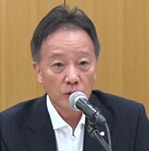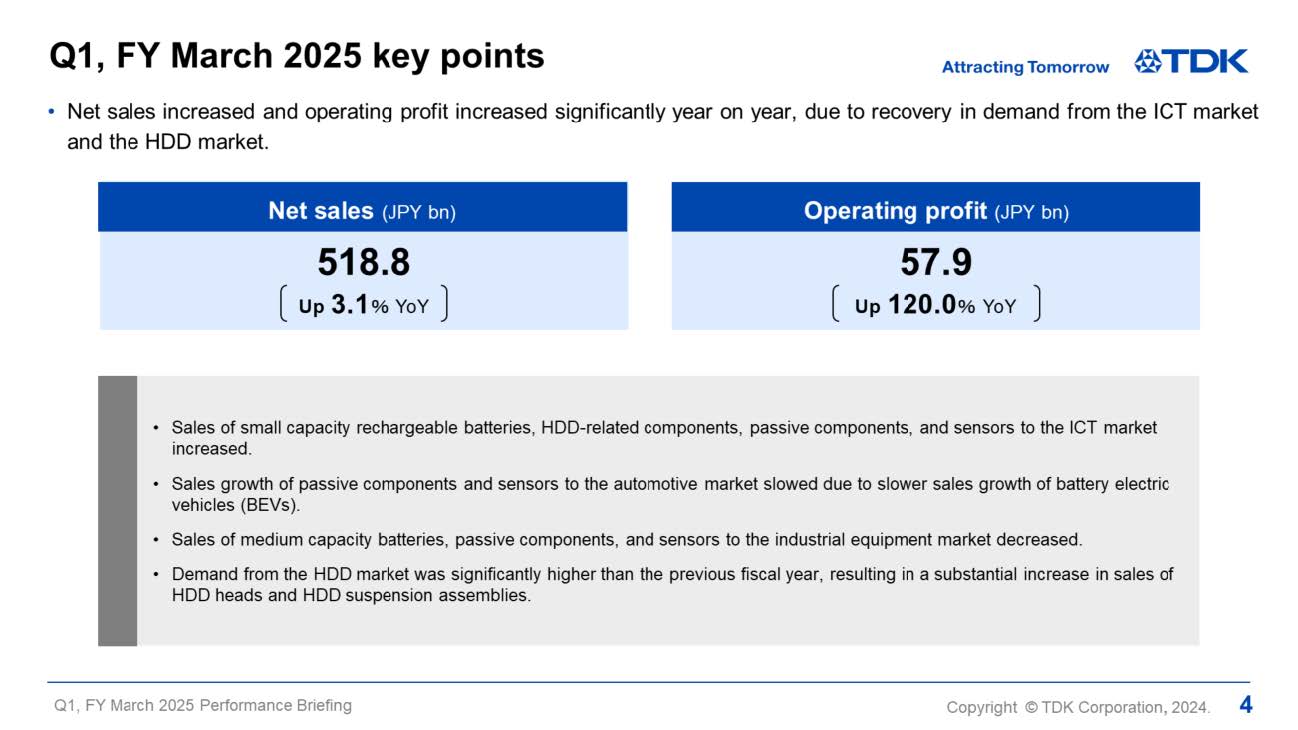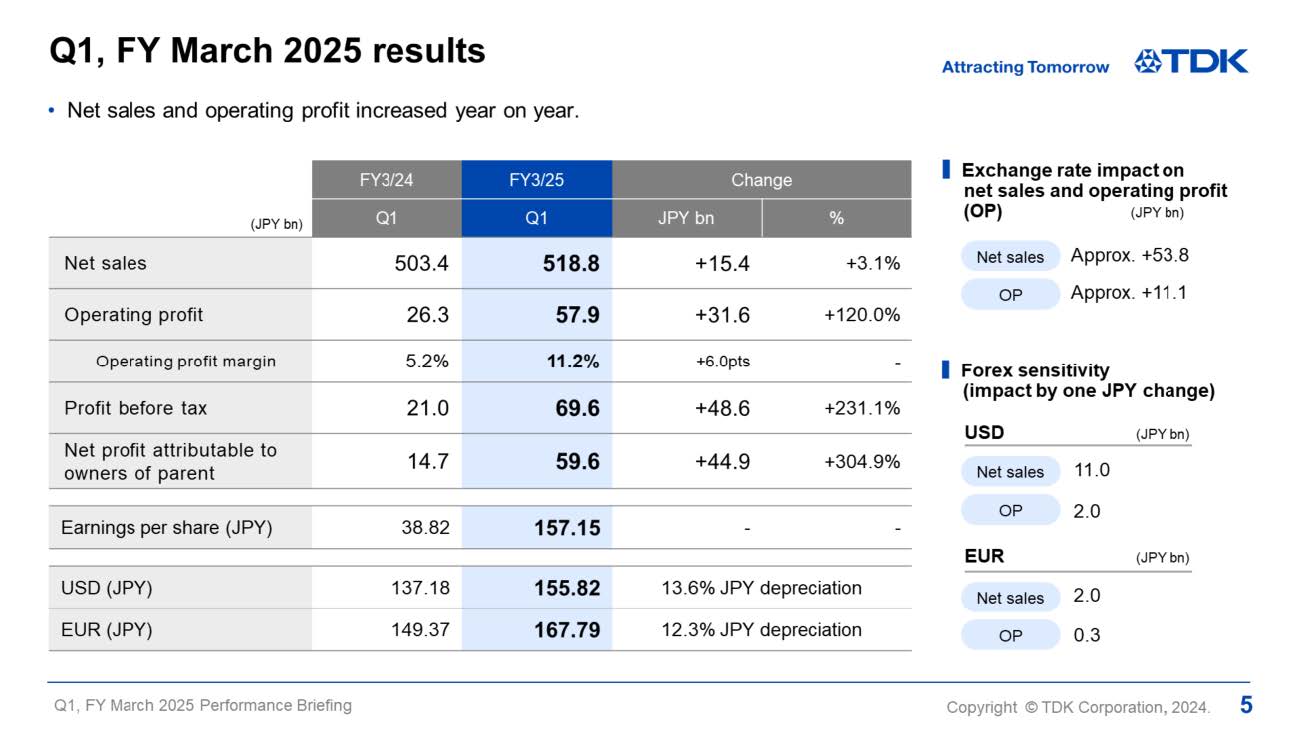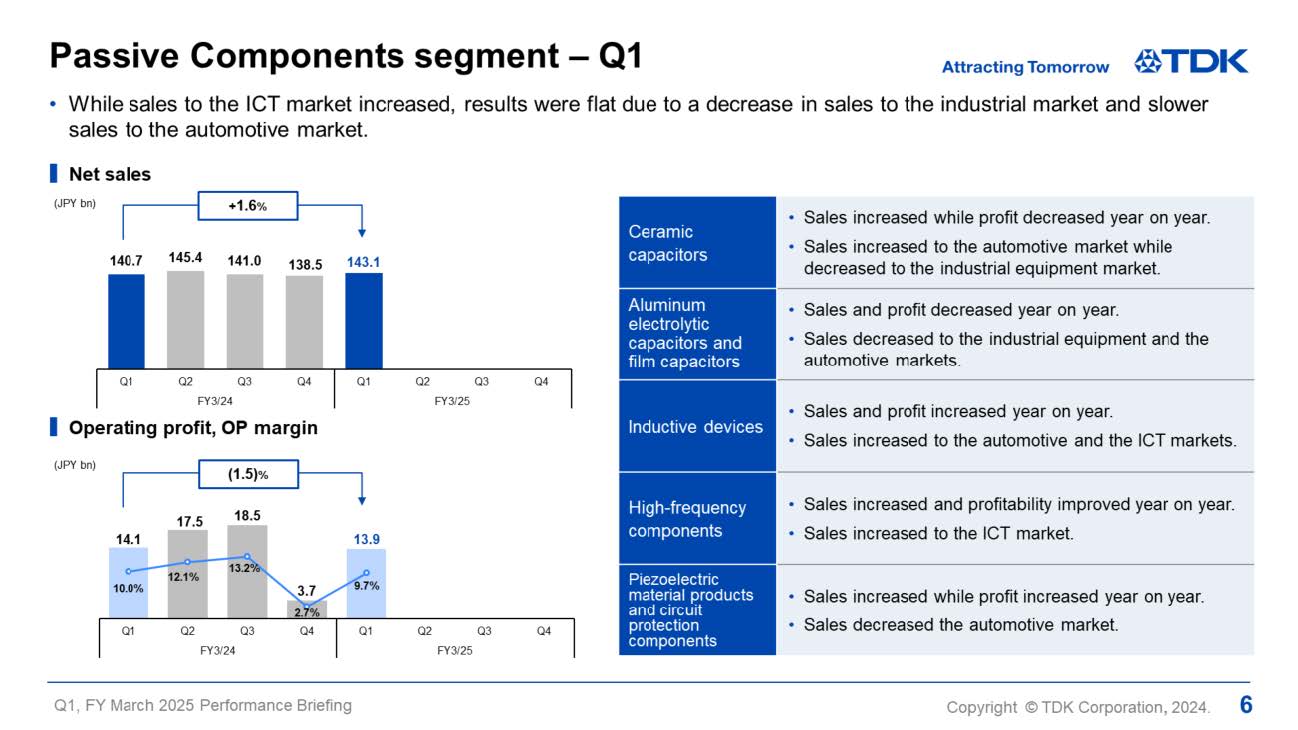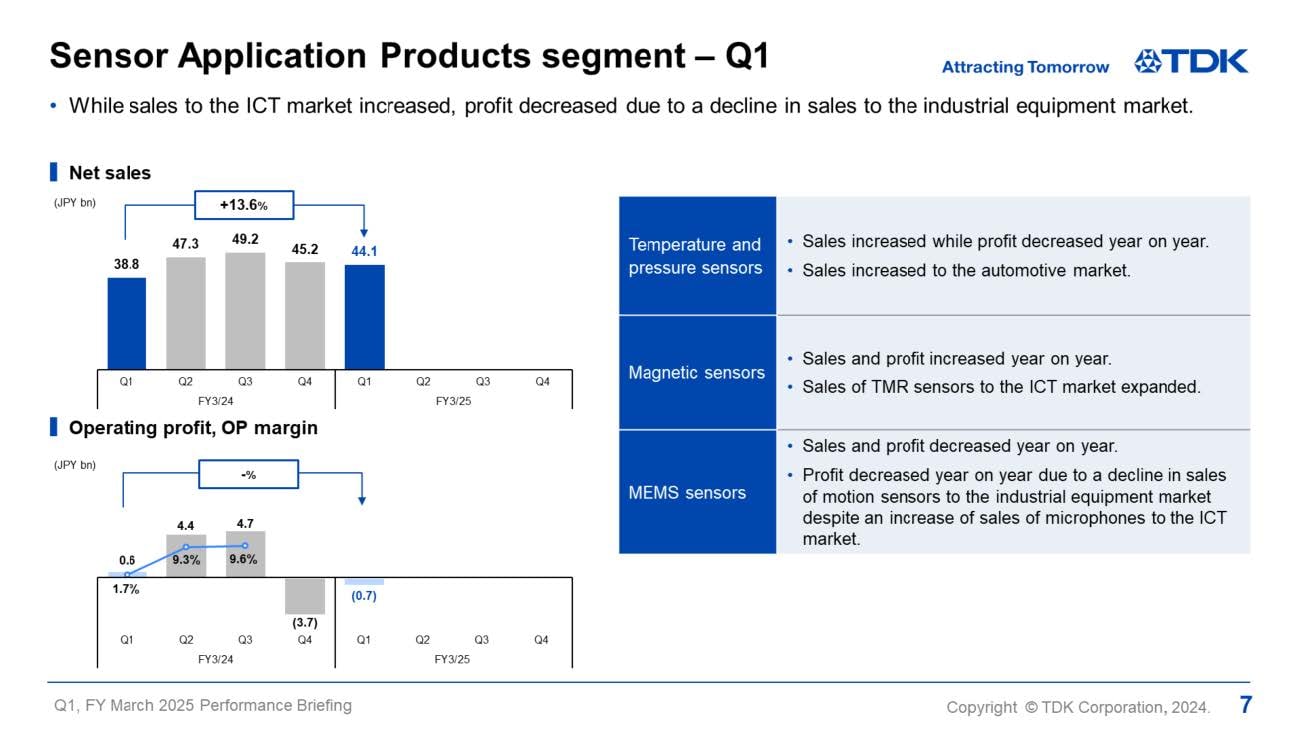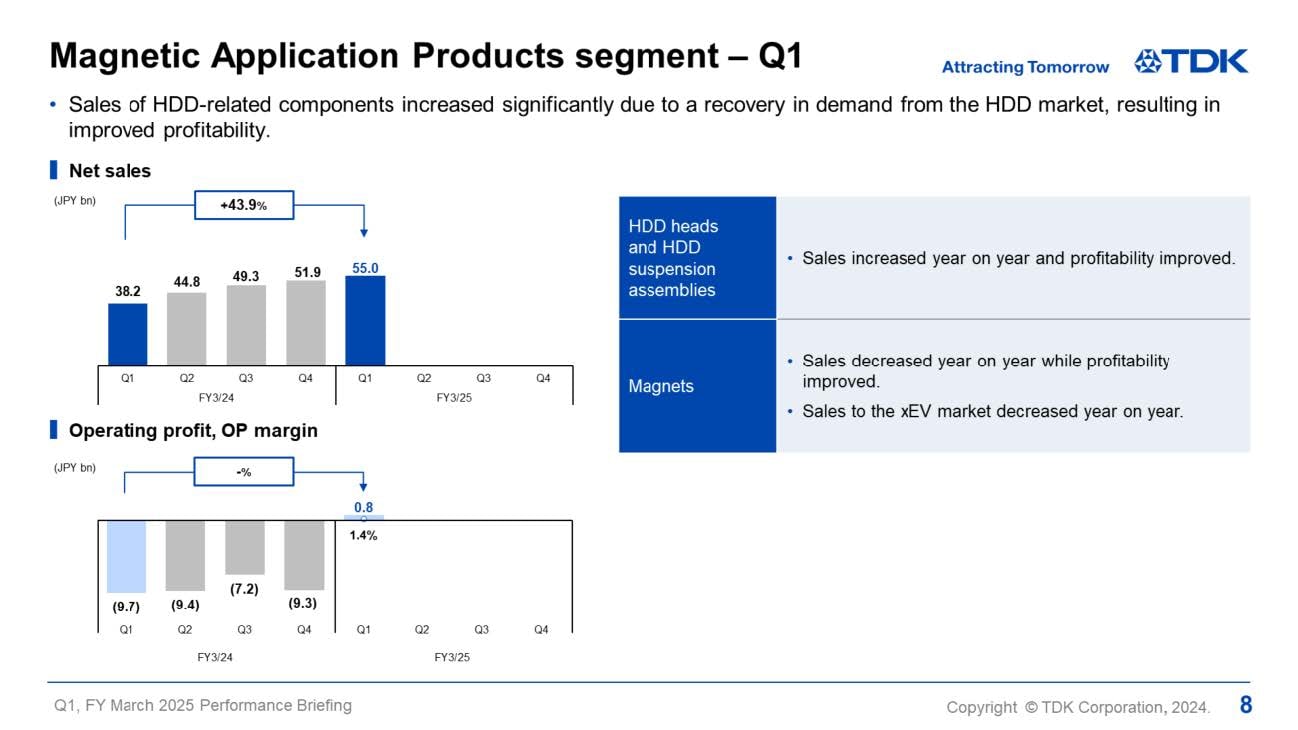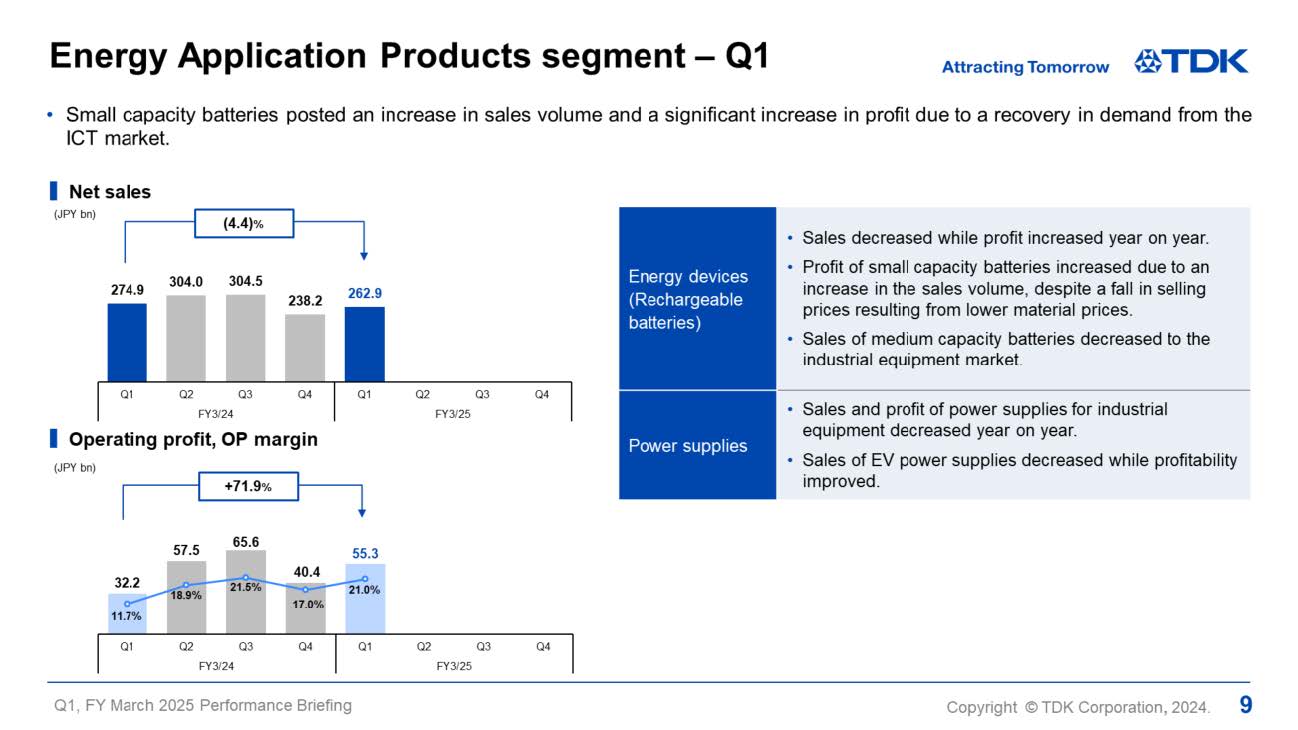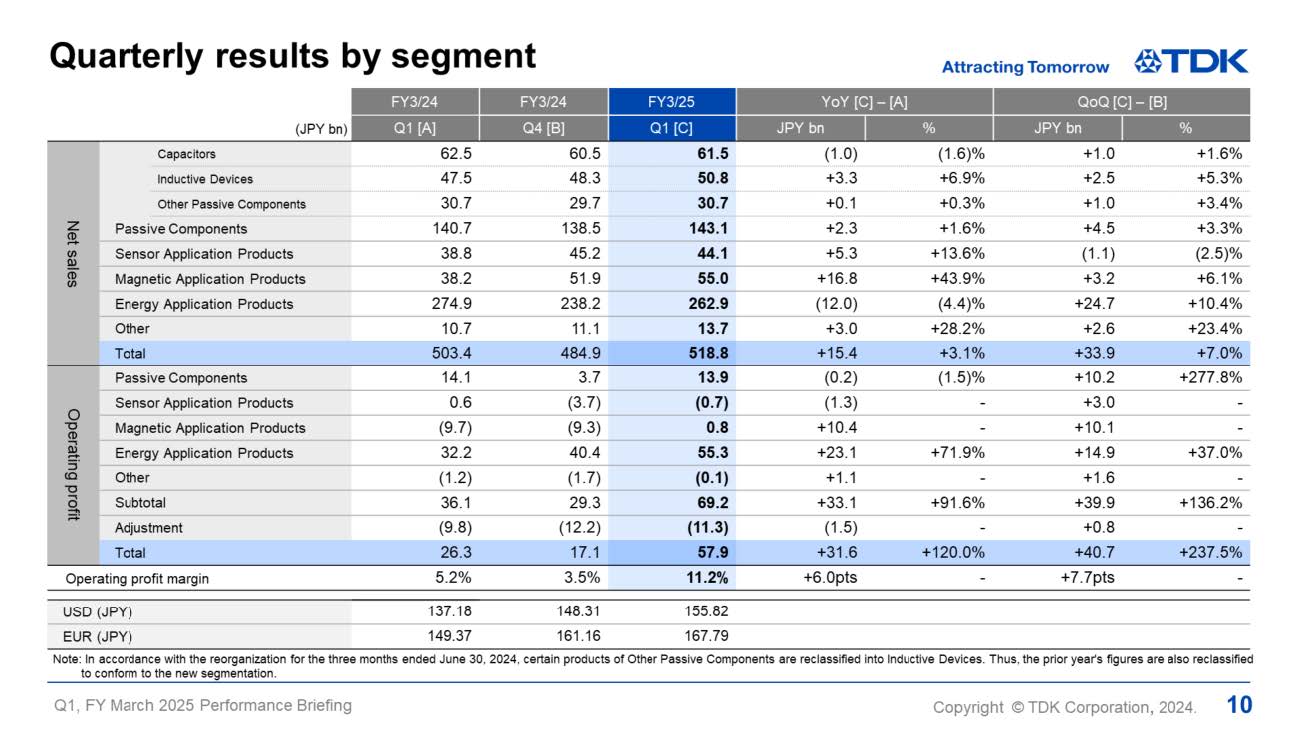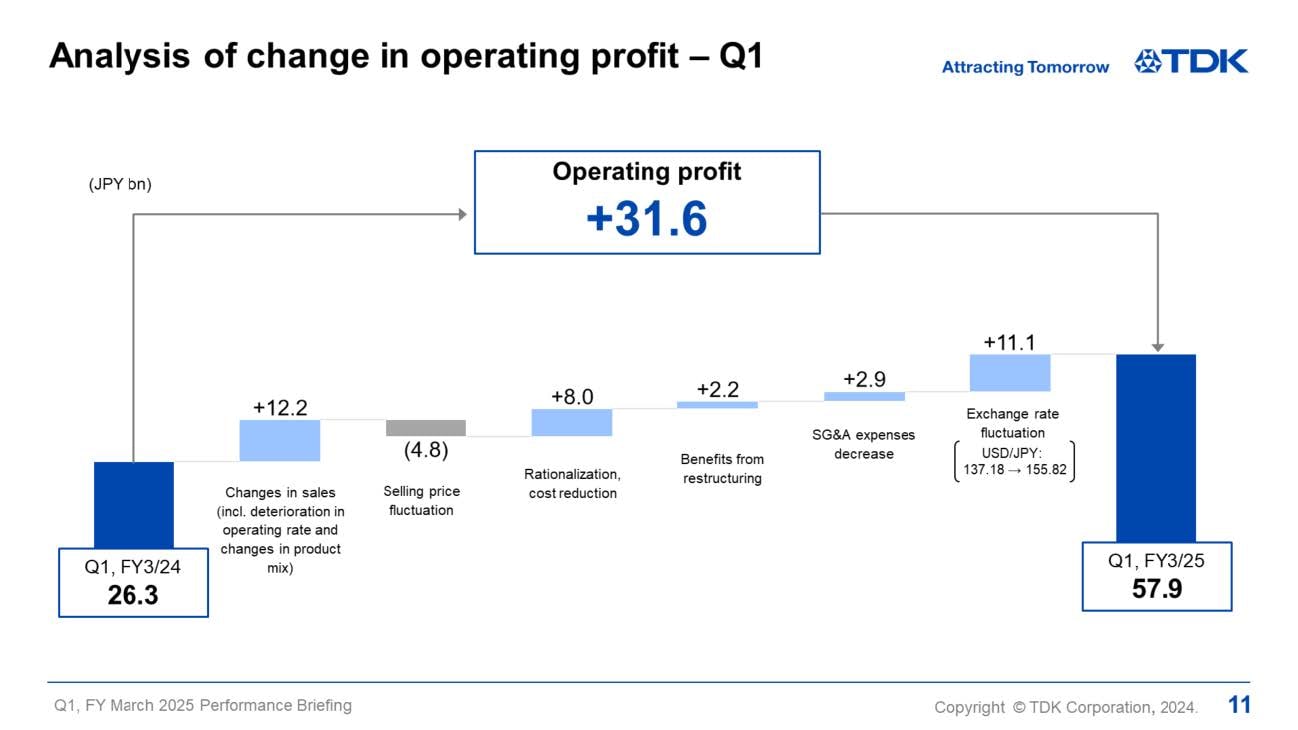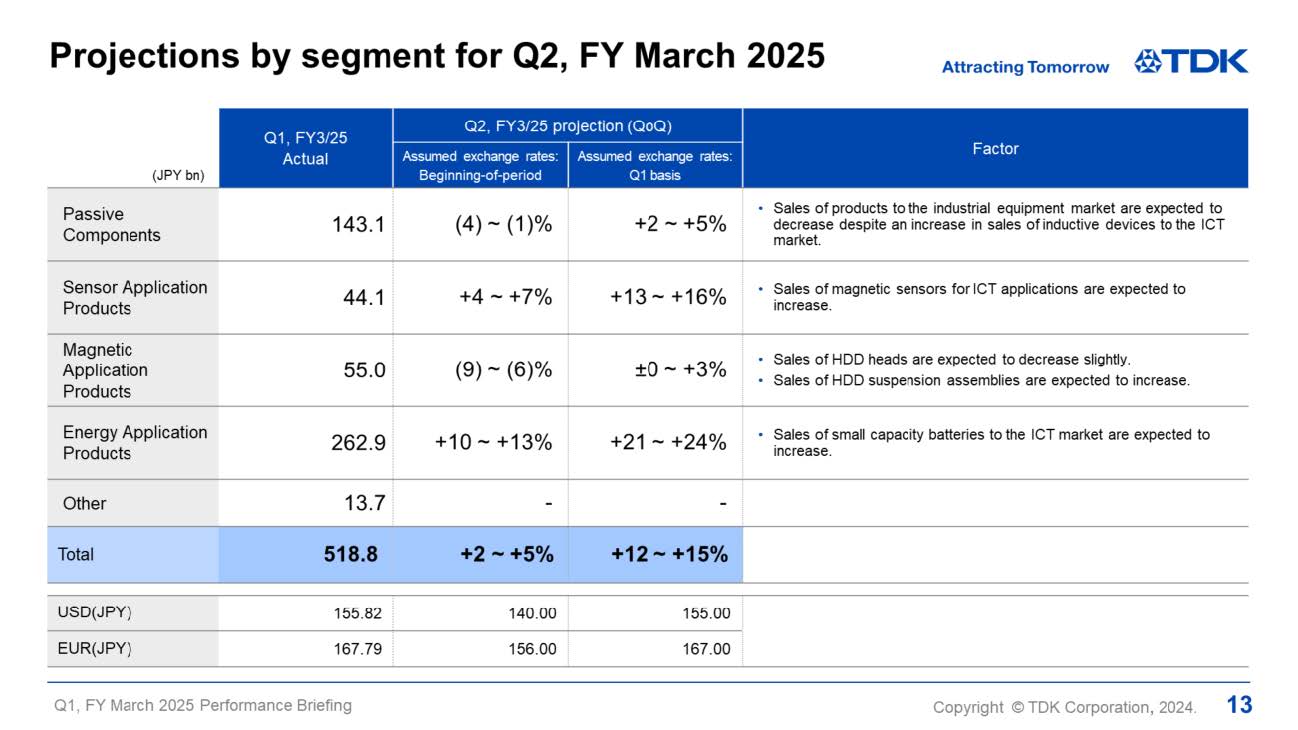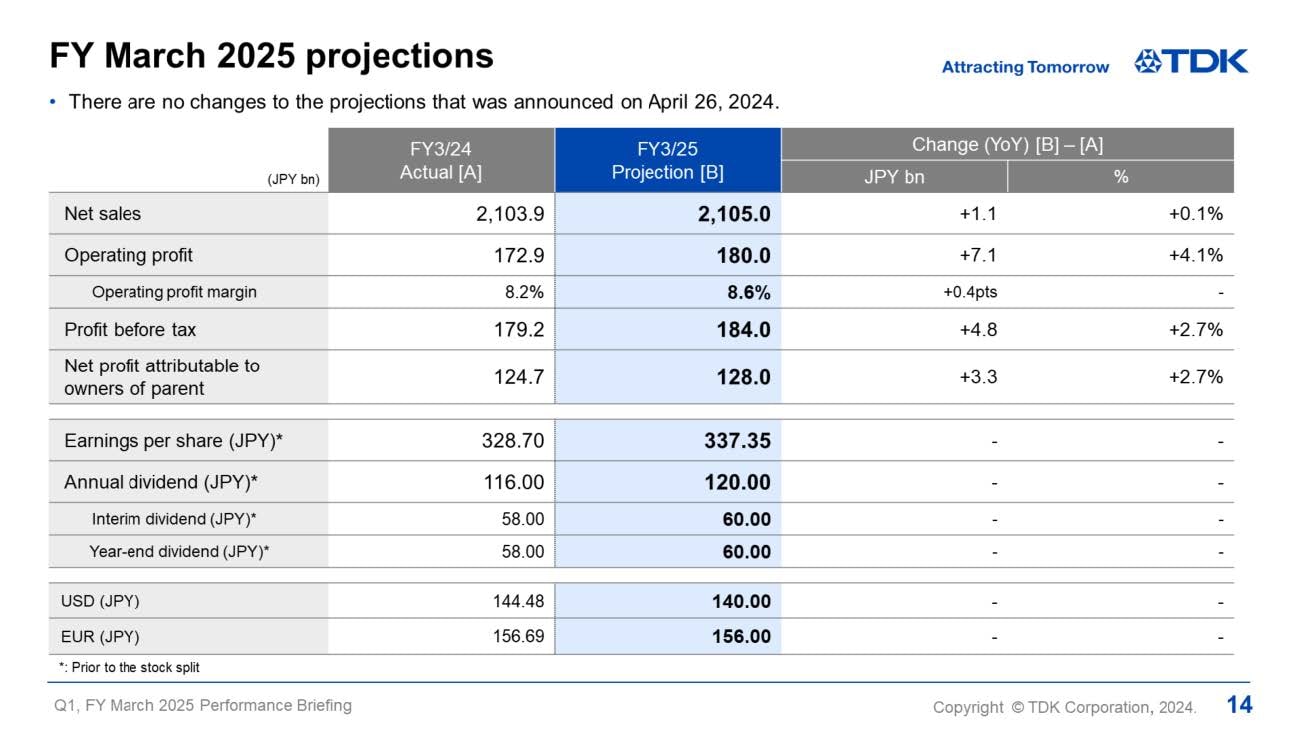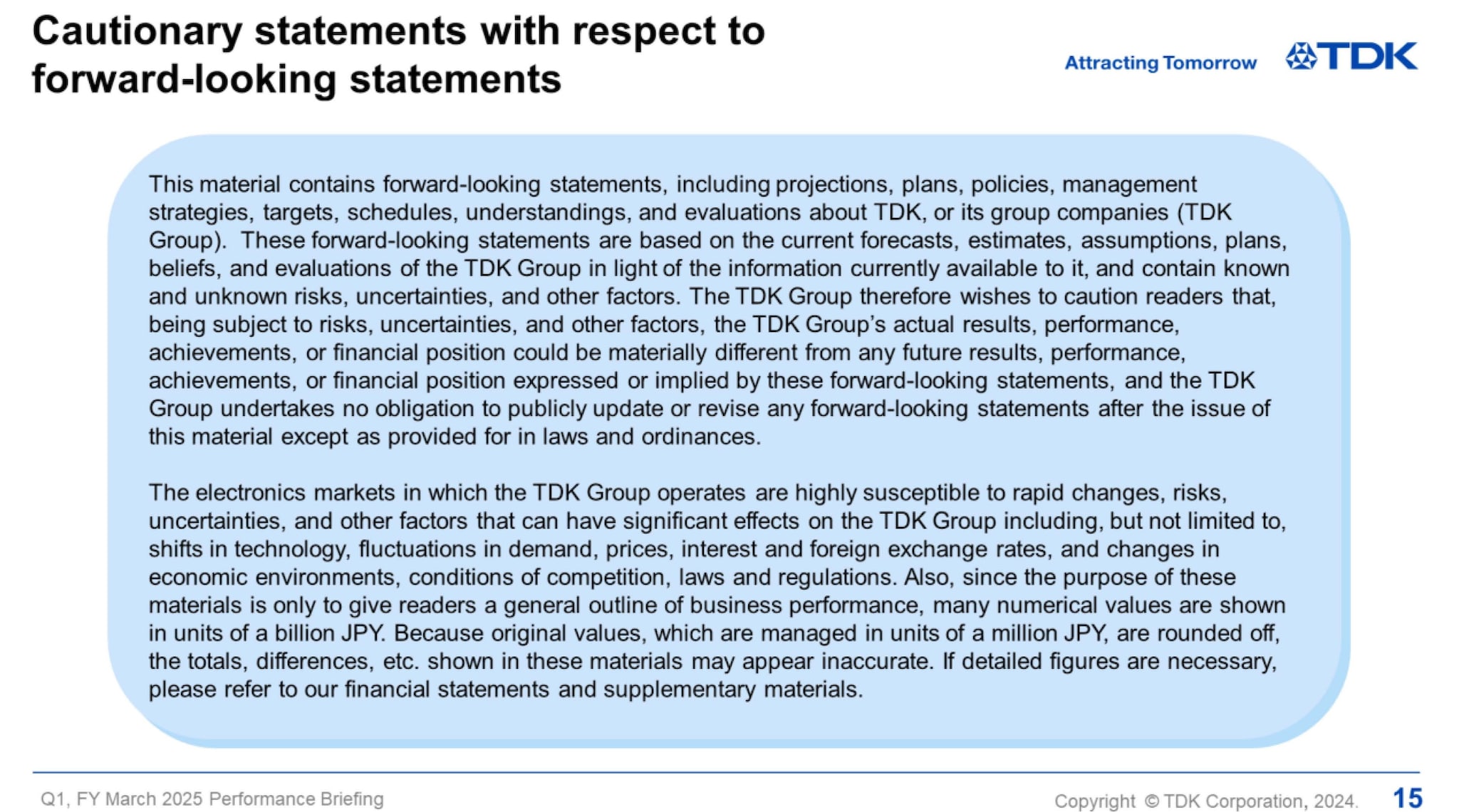1st Quarter of fiscal 2025 Performance Briefing (Speech Text)
1st Quarter Fiscal 2025 Results Highlights
Mr. Tetsuji Yamanishi
Senior Executive Vice President
Hello, I am Tetsuji Yamanishi. Thank you for taking the time to attend TDK’s performance briefing for Q1 of FY March 2025. I would like to explain the highlights of our consolidated results.
Q1, FY March 2025 key points
I would like to start with the key points of Q1.
The global economy remained unstable in Q1 due to the continued economic slowdown in China and the impact of the unrest in the Middle East, although North America remained robust and Europe showed signs of economic recovery. The yen continued to weaken significantly against the U.S. dollar and the euro.
In the electronics market, which has a large bearing on our earnings, an increase in replacement demand and other factors resulted in a recovery in the production of Information and Communication Technology (ICT) related products, such as smartphones and notebook PCs, on a year-on-year basis. Demand for nearline Hard Disk Drives (HDDs) for data centers also recovered strongly. In the automotive market, demand for battery electric vehicles
(BEVs) showed signs of slowing, resulting in lower component demand than we had expected at the beginning of the fiscal year. As a result, net sales for Q1 was up 3.1% year on year. Due to the recovery in component demand in the ICT market, sales of rechargeable batteries, passive components and sensors all increased, while growth in sales of passive components and sensors to the automotive market slowed due to slower sales of BEVs. Medium capacity batteries for the industrial equipment market became a full joint venture business in the period under review. On a year-on-year basis, our consolidated net sales decreased, as did sales of passive components and sensors.
Operating profit increased 120% year on year due to the sharp depreciation of the yen, an increase in sales of products for the ICT market, as well as rationalization and the benefits from restructuring implemented in the previous fiscal year.
Q1, FY March 2025 results
Next, I would like to present an overview of our Q1 results.
There was an increase of about JPY 53.8 billion in net sales and an increase of about JPY 11.1 billion in operating profit due to exchange rate fluctuations against the U.S. dollar and other currencies. Including this impact, net sales were JPY 518.8 billion, an increase of JPY 15.4 billion, or 3.1%, year on year, and operating profit was JPY 57.9 billion, an increase of JPY 31.6 billion, or 120%, year on year. Profit before tax was JPY 69.6 billion, an increase of JPY 48.6 billion, or 231%, year on year, including approximately JPY 8.0 billion in foreign exchange gain. Net profit attributable to owners of parent was JPY 59.6 billion, an increase of 305% year on year. Earnings per share amounted to JPY 157.15. In terms of exchange rate sensitivity, we estimate that a change of JPY 1 against the U.S. dollar will affect operating profit by about JPY 2 billion a year, the same as our previous estimate, while a JPY 1 change against the euro will have an impact of about JPY 0.3 billion a year, a decrease from the previous estimate.
Passive Components segment - Q1
I will now move on to Q1 segment results.
In the Passive Components segment, sales to the ICT market, such as for smartphone applications, increased, while demand from the industrial equipment market remained sluggish, and sales to the automotive market, such as for BEVs, slowed down. As a result, net sales were JPY 143.1 billion, a slight increase of 1.6% year on year. Operating profit was JPY 13.9 billion, a slight decrease of 1.5% year on year.
Profit of ceramic capacitors decreased due to a decline in sales to the industrial equipment market and the impact of a rise in fixed costs to accommodate production increases, although sales to the automotive market increased. Sales and profit of aluminum electrolytic capacitors and film capacitors decreased as a result of a decline in sales to the industrial equipment and automotive markets. Inductive devices increased in terms of both sales and profit as sales to the automotive and ICT markets rose. Sales of high frequency components increased due to higher sales to the ICT market, and profitability also improved. Piezoelectric material products and circuit protection components posted lower sales due to a decline in sales to the automotive market, while profit increased partly due to foreign exchange gains.
Sensor Application Products segment - Q1
In the Sensor Application Products segment, net sales amounted to JPY 44.1 billion, up 13.6% year on year. Operating profit was a loss of JPY 0.7 billion.
Sales of temperature and pressure sensors increased reflecting a rise in sales to the automotive market, while profit decreased as a one-time gain from the sale of assets was included in the previous year. In magnetic sensors, sales and profit of both Hall sensors and TMR sensors increased due to a rise in sales for smartphone applications. In MEMS sensors, the profitability of microphones improved as sales to the ICT market increased, while sales of motion sensors for industrial equipment applications declined. This resulted in a decrease in sales and profit for MEMS sensors as a whole.
Magnetic Application Products segment - Q1
In the Magnetic Application Products segment, net sales rose sharply by 43.9% year on year to JPY 55.0 billion, and a positive operating profit was secured, including approximately JPY 2.3 billion in one-time gains for HDD heads.
In HDD heads and HDD suspension assemblies, demand for nearline HDD heads for data centers increased 1.5 times year on year, resulting in a return to profitability for HDD heads and HDD suspension assemblies as a whole even when excluding one-time gains. For HDD heads, the sales volume increased 1.9 times year on year. However, it was slightly below the break-even volume after the restructuring, and the product remained slightly in the red excluding one-time gains. The sales volume of HDD suspension assemblies exceeded the break-even volume, and the product returned to profitability.
Although sales of magnets declined due to lower sales to the automotive market, profitability improved.
Energy Application Products segment - Q1
In the Energy Application Products segment, net sales decreased 4.4% year on year to JPY 262.9 billion, while operating profit rose 71.9% year on year to JPY 55.3 billion.
Rechargeable batteries decreased in terms of sales due to a decline in selling prices resulting from lower material prices and a decrease in consolidated sales due to the completion of the transfer of the medium capacity battery business to the JVs, while the sales volume of small capacity batteries for smartphones increased due to a rise in demand from the ICT market. As a result, sales for the segment as a whole decreased slightly from the previous year. On the other hand, operating profit increased significantly thanks to volume growth, effects of rationalization, and foreign exchange gains.
Power supplies for industrial equipment saw a decline in terms of both sales and profit as demand for industrial equipment applications failed to recover, while power supplies for EVs saw a decline in sales but an improvement in profitability.
Quarterly results by segment
Now, I will explain some of the factors behind the changes in segment sales and operating profit from Q4 of FY March 2024 to Q1 of FY March 2025.
First, in the Passive Components segment, net sales increased by JPY 4.5 billion, or 3.3%, from the fourth quarter of the previous fiscal year, and operating profit increased by 30%, excluding one-time expenses of JPY 7.0 billion in Q4 of the previous fiscal year. Sales of ceramic capacitors decreased mainly as a result of a fall in BEV demand, and operating profit decreased due in part to a decline in volume and an increase in costs to accommodate production increases. Aluminum electrolytic capacitors and film capacitors increased in terms of both sales and profit mainly due to an increase in demand from the industrial equipment market, such as for solar power equipment, despite a fall in sales to the automotive market. Inductive devices saw an increase in both sales and profit, driven by higher sales in all markets. High frequency components, piezoelectric material products and circuit protection components were flat in terms of both sales and profit.
In the Sensor Application Products segment, net sales decreased by JPY 1.1 billion, and operating profit declined slightly, excluding one-time expenses of JPY 3.3 billion in Q4 of the previous fiscal year. Temperature and pressure sensors decreased in terms of both sales and profit due to a fall in sales to the automotive market. Magnetic sensors saw a slight increase in sales due to higher sales for smartphone applications, despite lower sales to the automotive market, but profit was flat due to an increase in fixed costs to accommodate production increases. MEMS sensors decreased in sales as a result of a decline in the sales of motion sensors for drone and automotive applications, although sales of microphones for the ICT market increased. However, the deficit was reduced due to improved profitability in microphones.
In the Magnetic Application Products segment, net sales increased by JPY 3.2 billion, or 6.1%, and operating profit increased significantly, excluding one-time expenses of JPY 4.7 billion in Q4 of the previous fiscal year and one-time gains of JPY 2.3 billion in Q1 under review. Due to the recovery of total demand for nearline HDDs, the sales volume of HDD heads increased by approximately 9%, that of nearline HDD heads rose by approximately 26%, and that of HDD suspension assemblies increased by approximately 2%. As a result, the HDD head business as a whole increased in terms of sales and also returned to profitability even when excluding the one-time gain in Q1 under review. As for magnets, while sales decreased, the deficit was reduced.
In the Energy Application Products segment, net sales increased by JPY 24.7 billion, and operating profit increased by JPY 12.9 billion, excluding one-time expenses of JPY 2.0 billion in Q4 of the previous fiscal year. Rechargeable batteries increased in sales volume due to a rise in demand for small capacity batteries from the ICT market, market share gains and an increase in spot orders at the time of new product launches by customers. Medium capacity batteries increased in terms of both sales and profit due to higher sales for electric motorcycle applications. Power supplies for industrial equipment decreased in terms of both sales and profit, while power supplies for EVs saw an increase in sales and a reduction in loss.
Analysis of change in operating profit - Q1
Next is an analysis of the JPY 31.6 billion increase in operating profit for Q1. Operating profit increased by JPY 12.2 billion due to changes in sales, reflecting an increase in the sales volumes of rechargeable batteries, HDD heads and HDD suspension assemblies, although the sales volumes of passive components and sensors declined. The effects of rationalization for cost reduction and restructuring amounting to JPY 10.2 billion absorbed the JPY 4.8 billion decline in profit caused by changes in selling prices.
SG&A expenses decreased by JPY 2.9 billion, including one-time gains of approximately JPY 2.3 billion in HDD heads, and the weaker yen boosted profit by JPY 11.1 billion. These contributed to the JPY 31.6 billion increase in operating profit.
FY March 2025 Projections
Projections by segment for Q2, FY March 2025
I would now like to discuss our projections regarding changes in segment net sales for Q2. For Q2, we are not changing our exchange rate assumption of JPY 140 to the U.S. dollar, which we made at the beginning of the fiscal year. However, for the sake of comparison, my discussion will be based on the changes excluding exchange rate fluctuations.
In the Passive Components segment, we expect net sales to increase by 2–5% as a whole, mainly due to a slight increase in sales to the automotive market and an increase in sales of inductive devices to the ICT market, despite continued weakness in sales to the industrial equipment market.
In the Sensor Application Products segment, we expect net sales to increase by 13–16% as a whole, reflecting a rise in sales of temperature and pressure sensors to the automotive market, a significant seasonal increase in sales of magnetic sensors for smartphone applications, and an increase in sales of MEMS sensors due to strong microphone sales.
In the Magnetic Application Products segment, our sales projection is an increase of 0–3% as a whole, as we expect HDD production to increase by approximately 5% and nearline HDD production to grow by approximately 8%, as well as robust sales of HDD heads and HDD suspension assemblies and increased sales of magnets.
In the Energy Application Products segment, we expect net sales to increase by 21–24% as a whole, reflecting a significant rise in sales of small capacity batteries to the smartphone market, due in part to seasonality, an increase in sales of medium capacity batteries for ESS applications, a decrease in sales of industrial power supplies due to continued weak demand, and an increase in sales of power supplies for EVs to the automotive market.
FY March 2025 projections
I would like to go over our full-year projections for FY March 2025.
Our Q1 results and our expectations for Q2 are ahead of the projections we made at the beginning of the fiscal year. However, we are maintaining the full-year projections we announced at the beginning of the fiscal year, as we believe we need to assess demand trends in key markets in the second half of the year.
Our exchange rate assumptions for Q2 and beyond are also unchanged from those made at the beginning of the fiscal year, which were JPY 140 to the U.S. dollar and JPY 156 to the euro.
This concludes my presentation. Thank you for your attention.

